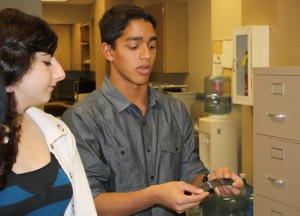Outreach
Summer 2016 High School Apprenticeship Program (HSAP) and Undergraduate Research Apprenticeship Program (URAP)
The AIMS Center is participating in HSAP and URAP through the Army Educational Outreach Program (AEOP). High school and Undergraduate students will have the opportunity to work on research projects within the Center, gaining real world research experience. The application deadline is January 30, 2016.
Fulton Undergraduate Research Initiative article
Ira A. Fulton Inner Circle article
Peggy Payne students learning materials diagnostics at ASU internship
McClintock High School, and Peggy Payne Academy, students Abhishek Rajadas and Evi Postelnicu are working to make air travel safer.
Under the guidance of Dr. Aditi Chattopadyay, Director of ASU’s Adaptive Intelligent Materials & Systems (AIMS) Center, and working alongside doctoral student Yingtao Liu, Abhishek and Evi use sensors, fiber optics, lasers and high-tech cameras to find microscopic flaws in composite materials intended for use in airplanes. Aircraft constructed with composite materials are lighter and more durable; and, because a lighter airplane consumes less fuel, operating costs are lower.
To earn high school credit the students spend at least five hours every week in the lab and complete journal entries and daily reports. Upon completion of their internships they will be required to write a research paper.
Aside from the obvious benefits-working on cutting edge technology and gaining real-world experience-the students are acquiring skills they can apply to their daily lives. Abhishek finds “real practical uses everyday (for what I learn), such as excel programs to analyze my swimming times and build training programs.” As he explains, “it’s hard for kids my age to think about things 40,000 feet in the sky, so we have some fun side projects, like trying to make a better skateboard from composite materials.”
What does an ASU internship mean for the future of these Payne Academy sophomores? The skills they are gaining make them extremely desirable to colleges says Director Laura Zinke. “I believe…internship opportunities provide the real-world experience that help students become more competitive in the applicant pool when they begin the college application process. It provides an edge that many students don’t have in high school.” She added that letters of recommendation from highly-respected and well-known professors carry considerable weight.
The Peggy Payne Academy currently has seven students participating in internships.
Cactus Shadows High School students assist in critical damage detection
Stephanie Rioux and Mackenzie Brown, students from Cactus Shadows High School, worked for 6 months under the guidance of Prof. Aditi Chattopadyay, Director of ASU’s Adaptive Intelligent Materials & Systems (AIMS) Center, alongside doctoral student Clyde Coelho and master’s student Cristobal Hiche.
The students learned and worked on Structural Health Monitoring of woven composite laminates using flash thermography to detect sub-surface damage due to low energy/velocity impacts. This is a critical issue in composite structures which can be damaged by the drop of a tool during maintenance or mishandling during transport and storage of a given composite part. This can cause delamination, fiber breakage, or matrix cracking within the composite layers which is not visible on the surface. These sub-surface damages could significantly reduce its strength and compromise the safety of the given structure.
Stephanie and Mackenzie worked on their independent study with the goal of presenting their results at their high school science competition and the state science fair. Also, this was a great opportunity for them to learn about science and engineering and the work being done in a lab environment. Both students want to work in the science, technology & engineering field and the work being done at ASU in the AIMS center strengthened their decision. They realized that while science/engineering can be challenging, it can be a lot of fun too!



